Related Research Articles
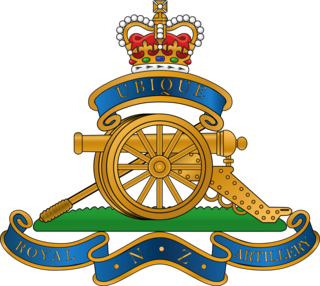
The Royal Regiment of New Zealand Artillery is the artillery regiment of the New Zealand Army. It is effectively a military administrative corps, and can comprise multiple component regiments. This nomenclature stems from its heritage as an offshoot of the British Army's Royal Artillery. In its current form it was founded in 1947 with the amalgamation of the regular and volunteer corps of artillery in New Zealand. In 1958 in recognition of services rendered it was given the title the Royal Regiment of New Zealand Artillery.

The Royal Regiment of Australian Artillery, normally referred to as the Royal Australian Artillery (RAA), is a Regiment of the Australian Army descended from the original colonial artillery units prior to Australia's federation. Australia's first guns were landed from HMS Sirius and a small earthen redoubt built, near the present-day Macquarie Place, to command the approaches to Sydney Cove. The deployment of these guns represents the origins of artillery in Australia. These and subsequent defences, as well as field guns, were operated by marines and the soldiers of infantry regiments stationed in Australia. Unlike their British and Canadian equivalents, there are no regiments of horse artillery in the order of battle of the Royal Australian Artillery. The First World War saw the raising of 60 field, 20 howitzer, and two siege batteries along with the heavy and medium trench mortar batteries. Until 19 September 1962 the Australian Artillery was referred to as the 'Royal Australian Artillery', however, on this date Queen Elizabeth II granted the RAA the title of 'The Royal Regiment of Australian Artillery'. The Regiment today consists of Regular and Reserve units.

The M119 howitzer is a lightweight 105 mm howitzer, used by the United States Army. It is the American licensed version of the British L119 light gun. The M119 is typically towed by the M1097 or M1152 High Mobility Multi-Purpose Wheeled Vehicle (HMMWV), and can be easily airlifted by helicopter, or airdropped by parachute.

The L118 light gun is a 105 mm towed howitzer. It was originally designed and produced in the United Kingdom for the British Army in the 1970s. It has since been widely exported. The L119 and the United States Army's M119 are variants that use a different type of ammunition.
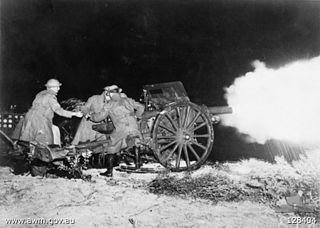
The 1st Regiment, Royal Australian Artillery is a close support regiment attached to the 7th Brigade at Enoggera Barracks in Queensland. The unit was formed in 1914 under the name 1st Australian Field Artillery Brigade, part of 1st Division Artillery during World War I and later served in World War II and the Vietnam War. It is currently re-equipping with M777A2 lightweight towed howitzers.
13 Field Battery, Royal Australian Artillery was formed in New South Wales during September 1915 as the 13th Field Artillery Battery, part of 5th Field Artillery Brigade. Today 13 Field Battery is one of 4 batteries that make up the 1st Field Regiment, part of 7 Brigade.
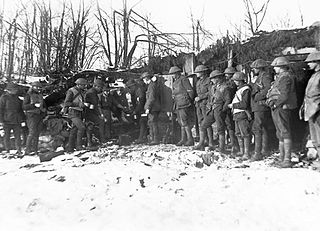
The 104 Field Battery, Royal Australian Artillery was formed in the town of Moascar in Egypt during March 1916 during the First World War, as the 104th Field Artillery (Howitzer) Battery, part of 4th Field Artillery Brigade. The battery was disbanded in 1919, but the name was used for a new battery raised in 1965, which later formed part of the Auustralian military involvement in the Vietnam War. It is now one of three gun batteries in 1 Regt RAA.
The 4th Regiment, Royal Australian Artillery is an artillery unit of the Australian Army. Currently it provides close artillery support to the 3rd Brigade and is based at Chau Pha Lines, Lavarack Barracks in Townsville, Queensland. The regiment was raised in its current form in 1960 and is currently re-equipping with M777A2 lightweight towed howitzers. The regiment deployed during Australia's commitment to the Vietnam War and has subsequently deployed to Singapore and East Timor.

The 105th Medium Battery is a unit of the Royal Regiment of Australian Artillery that can trace its history back to March 1916, when it was raised as 105th Howitzer Battery in Egypt. The battery is based at Gallipoli Barracks, Enoggera, Queensland, as a full-time regular army unit and is one of three batteries that make up the 1st Regiment, in the 7th Brigade.
3rd Regiment Royal Horse Artillery is a regiment of the Royal Horse Artillery in the British Army. They are currently based at Albemarle Barracks, Northumberland, England.

The Sri Lanka Artillery (SLA) is the artillery arm of the Sri Lanka Army. It is made up of ten regular regiments and two volunteer regiments. The SLA is headquartered at Panagoda Cantonment, Panagoda.

The 3rd Field Artillery Regiment (Mountain) (Italian: 3° Reggimento Artiglieria Terrestre (montagna)) is a field artillery regiment of the Italian Army, specializing in mountain warfare. The regiment is based in Remanzacco in Friuli-Venezia Giulia and assigned to the Alpine Brigade "Julia". The regiment was formed in 1909 by the Royal Italian Army as 2nd Mountain Artillery Regiment. In World War I the regiment's groups and batteries served on the Italian front.
The 8th/12th Regiment, Royal Australian Artillery, was formed at the Holsworthy Barracks on 16 November 1973 through the amalgamation of the 8th Medium Regiment (RAA) and the 12th Field Regiment (RAA). The Regiment provides field artillery support to the 1st Brigade based in Darwin. It is currently equipped with 155mm M777 Howitzers.

The Rocket Forces and Artillery of the Ukrainian Ground Forces consist of units armed with tactical missiles, howitzers, cannons, mortars, jet-propelled and anti-tank artillery. They are tasked to destroy human resources, tanks, artillery, anti-tank weapons, aircraft, air defense and other important installations operations.
The 7th Field Regiment, Royal Australian Artillery was an Australian Army Reserve artillery unit with its headquarters at Pymble, New South Wales, and was part of 8th Brigade until it was disbanded in early 2013.
The 103rd Medium Battery is an artillery battery unit of the Royal Australian Artillery. The battery was formed in 1916, known as the 103rd Field (Howitzer) Battery and served during World War I. Its successors have fought in the Indonesia–Malaysia confrontation and the Vietnam War and the battery is currently part of the 8th/12th Regiment, Royal Australian Artillery, based in Darwin, Northern Territory, as part of the 1st Brigade.
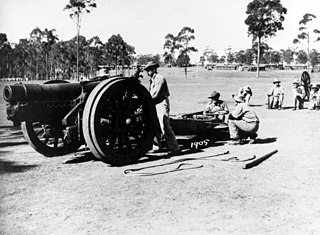
The 2/1st Medium Regiment was an artillery regiment of the Australian Army during World War II. Raised in 1940 as part of the all volunteer Second Australian Imperial Force, the regiment undertook garrison duties in Australia, Nauru and on Ocean Island, and served in the Middle East. It was converted to a field regiment, designated the 2/13th Army Field Regiment, due to a lack of howitzers, but was later converted back into a medium regiment. During 1943–1944, the regiment served as the 2/13th Composite Anti Aircraft Regiment before returning to the medium role. It was disbanded in July 1945, in Queensland.
The 23rd Regiment, Royal Australian Artillery was an Australian Army artillery regiment of the Australian Army. Raised in 1948 as a Citizen Military Forces anti-tank unit designated the 3rd Anti-Tank Regiment, it was converted to a field artillery regiment in the 1950s. It supported the 5th Brigade until being reduced to a battery-sized sub unit, and assigned to the 9th Regiment, Royal Australian Artillery in 2018.
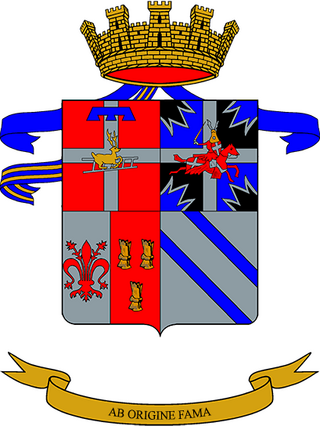
The 5th Field Artillery Regiment "Superga" is a field artillery regiment of the Italian Army. The regiment is the army's only multiple rocket launcher unit and equipped with M270A1 MLRS-I launchers. The regiment is based in Portogruaro in Veneto and assigned to the Artillery Command. The regiment is the Italian Army's senior artillery regiment and was formed in 1850 by the Royal Sardinian Army. In 1855-56 the regiment deployed six batteries to Crimea for the Crimean War and in 1859 it fought in the Second Italian War of Independence. In the 1860 it participated in the Piedmontese invasion of Central and Southern Italy. In 1861 the regiment joined the Royal Italian Army and in 1866 it fought in the Third Italian War of Independence. During World War I the regiment served on the Italian front. In 1935 the regiment was assigned to the 1st Infantry Division "Superga", which in 1940 participated in the invasion of France. In fall 1942 the division was transferred to Tunisia for the Tunisian campaign. The division and its regiments surrendered there to the British forces on 12 May 1943.

The 41st Regiment "Cordenons" is a Surveillance and Target Acquisition unit of the Italian Army. Originally a field artillery regiment, the regiment is today a multi-arms unit operationally assigned to the Tactical Intelligence Brigade, which combines elements of the artillery and signal arms. The regiment is based in Sora in Lazio.
References
- ↑ "41st Australian Field Artillery Battery". www.awm.gov.au. Retrieved 8 July 2024.
- ↑ "11th Field Artillery Brigade". vwma.org.au. Retrieved 8 July 2024.